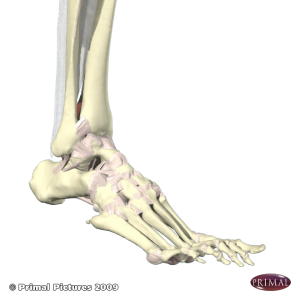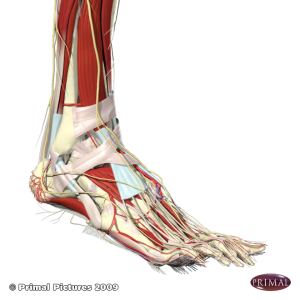Ankle Ligament Injury
Lateral Ankle Ligament Injury (rolled ankle)
What is it?
A lateral ligament injury of the ankle usually refers to a tear of one or more of the ligaments on the outside (lateral) of the ankle. The lateral ligaments consist of three ligament bands (lateral ligament complex) which provide stability to the ankle joint. The extent of injury to the lateral ligament complex can vary from a mild sprain (only a few fibres damaged) to a complete rupture of one or more ligaments (the full thickness of the ligament has been torn).
How does it happen?
The ligaments are damaged when they are overstretched. This commonly occurs when the foot and ankle are forcibly rolled inwards. This injury is often referred to as a ‘rolled ankle’. The ankle may be rolled during rapid changes in direction, on uneven surfaces, or treading on a ball or opponent’s foot.
The first sensation after a lateral ligament sprain is pain on the outside and front of the ankle. There may also be an audible snap, crack or tear. Depending on the severity of the injury the outside and front of the ankle may swell and you may have difficulty walking due to pain. Swelling may be immediate or occur over a period of hours. The ankle may also feel weak. Over the coming days, bruising may develop which can sometimes extend up the leg and down to the toes.
What should you do?
In simple terms R.I.C.E.
Rest – Stop your activity or sport and limit the amount of weight you put through the ankle. This may involve using crutches. A protective brace or specially applied strapping can help to limit the movement of the ankle thus minimising the damage to the lateral ligament complex.
Ice – apply ice to the injured area for 15-20 minutes every 1-2 hours. Ideally it should be applied using crushed ice wrapped in a moist cloth or towel. Avoid holding ice directly onto the skin as this can cause damage to the skin in the form of an ice burn.
Compression – an elastic bandage or Tubigrip bandage should be applied in an even manner extending from the base of the toes to the middle/top of the calf. It should be firm but not tight enough to cause pain.
Elevation – You should lie with your ankle resting comfortably on a chair or similar using pillows for comfort so that the ankle is above the level of your heart.
The first 48 hours is the most important time in the treatment and management of this injury. You will maximise your healing potential by following this simple regime as closely as possible within the first 48 hours and consulting with an appropriately qualified Health Professional preferably within 2 days of the initial injury.
What you shouldn’t do
Activities that increase blood flow to the injured area should be avoided. This includes hot showers, heat rubs, alcohol and excessive activity. Most importantly, do not ignore the problem. Even the simplest of ankle sprains can often lead to recurrent or chronic ankle problems if it is not appropriately diagnosed and treated.
Could there be any long-term effects?
Many lateral ankle ligament sprains resolve without complication within 4-6 weeks. However, a proportion of injuries can result in longer-term effects depending on the specific nature and severity of the injury. When the ankle is rolled, in addition to injury of the lateral ligament complex, a number of other structures in the vicinity may also be injured. These include bone, cartilage, muscles and tendons. Injuries to these structures can produce persistent pain and swelling which can impair recovery. An incorrect diagnosis or poor management of your injury may result in reduced range of movement, weakness and an increased chance of reinjuring the ankle. When the lateral ligament complex is injured, specialised nerve receptors situated within the ligaments that are involved with balance can be damaged. Balance is then compromised leaving the ankle susceptible to further injury. The good news is that with a structured and targeted rehabilitation programme prescribed by a qualified individual, function can be restored thus reducing the likelihood of future ankle injury.
After initial R.I.C.E. treatment, the aim of subsequent treatment is to restore the ankle to full function. This involves restoration of full range of motion, strengthening the muscles around the ankle, improving the balance (proprioception) with specific exercises before a graded return to full activity. A physiotherapist will also be able to advise you on other preventative measures such as the use of strapping tape or ankle braces. You will also be able to discuss appropriate methods for maintaining a degree of cardiovascular fitness and muscle function during your rehabilitation.
Disclaimer: This information is not a substitute for medical advice and you should seek professional advice from a doctor, physiotherapist or other healthcare professional.







